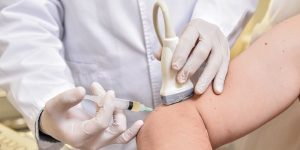Plasma Rich Platelet (PRP) Injections vs. Cortisone Injections for Lateral Epicondylitis: Understanding the Differences and Considerations

When it comes to treating lateral epicondylitis, commonly known as tennis elbow, two commonly used injections are Plasma Rich Platelet (PRP) injections and cortisone injections. While both injections aim to alleviate pain and promote healing, there are important differences to consider when deciding which treatment option is most suitable for an individual. Let’s explore these differences and the factors that may influence the choice between PRP and cortisone injections:
PRP Injections:
- Plasma Rich Platelet (PRP) injections involve extracting a small sample of the patient’s blood, which is then processed to concentrate the platelets. Platelets contain growth factors that are thought to enhance the healing process. The concentrated platelet solution is then injected into the affected area, such as the tendon attachment site in lateral epicondylitis.
Benefits of PRP Injections:
- Potential to stimulate tissue regeneration and promote healing.
- May have longer-lasting effects compared to cortisone injections.
- Considered a natural treatment option as it utilizes the patient’s blood components.
Considerations for PRP Injections:
- Multiple injections over a period of weeks or months may be required.
- Higher cost compared to cortisone injections.
- Limited insurance coverage for PRP injections.
- Effectiveness may vary among individuals, and not all cases of lateral epicondylitis respond equally well to PRP injections.
Cortisone Injections:
- Cortisone injections involve the administration of a corticosteroid medication directly into the affected area. Corticosteroids are potent anti-inflammatory agents that help reduce inflammation and alleviate pain associated with lateral epicondylitis.
Benefits of Cortisone Injections:
- Rapid reduction of inflammation and relief of pain.
- Can provide short-term symptomatic relief.
- Generally less expensive compared to PRP injections.
Considerations for Cortisone Injections:
- Temporary pain relief, with potential for symptoms to return over time.
- Repeated cortisone injections may carry risks, including tendon weakening or degeneration.
- Not recommended for long-term or chronic conditions.
- May not address the underlying cause of lateral epicondylitis or promote long-term healing.
Choosing between PRP and Cortisone Injections:
The decision between PRP and cortisone injections depends on various factors, including the individual’s specific condition, treatment goals, and preferences. Considerations for choosing one over the other may include:
- Severity and duration of symptoms: Cortisone injections may be appropriate for short-term relief of severe pain, while PRP injections may be considered for chronic or recurrent cases.
- Desire for long-term healing: If promoting tissue regeneration and long-term healing is a priority, PRP injections may be favored.
- Previous treatment response: If cortisone injections have been ineffective or provided only temporary relief, PRP injections may be explored as an alternative.
It is essential to consult with a healthcare professional or specialist who can evaluate your individual case and provide personalized recommendations. They can help determine the most suitable treatment approach based on your specific needs, preferences, and the latest medical evidence.
Please note that this information is provided as a general overview, and individual circumstances may vary.

